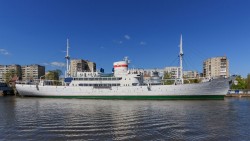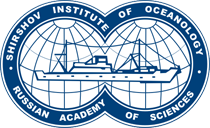The Museum of the IO RAS
was established in March 1998 in agreement with the Museum Council of the Russian Academy of Sciences and in accordance with the Decree of the Department of Oceanography, Atmospheric Physics and Geography.
The Museum of the IO RAS was created with the aim of studying, preserving, accumulating and popularizing materials of museum significance.
The main tasks of the Museum are:
- collection and storage of archival materials, museum items and collections related to the history of the Institute;
- creation of a library of scientific and popular science literature on the history of oceanology;
- organization of the permanent exposition of the Museum and its improvement;
- creation and organization of temporary exhibitions;
- creation of photo and video archives on the history of the Institute of Oceanology;
- systematization, accounting and cataloging of fund materials and collections, including with the help of modern computer programs for accounting museum funds;
- participation in the work of scientific conferences and meetings on the history of oceanology;
- improvement of professional knowledge: participation in conferences, meetings and schools held by the museums of our country;
- conducting scientific and educational work.
Coordination of work and methodological management of the museum's activities is carried out by the Museum Council under the Presidium of the Russian Academy of Sciences. The Museum of the Institute of Oceanology is included in the list of museums of the Russian Academy of Sciences and is a permanent member of the program of the Presidium of the Russian Academy of Sciences "Program for Support and Development of Museums of the Russian Academy of Sciences".
A Brief History of the Museum
The Museum of the Institute of Oceanology was organized on the initiative and with the direct participation of Marina P. Shirshova, a geochemist, daughter of the founder and first director of the Institute of Oceanology and with the support of the Director of the IO RAS (1995 - 2006), Corresponding Member of the Russian Academy of Sciences Professor Sergey S. Lappo.

In 1990, the Museum of the World Ocean (MWO) was established in Kaliningrad, the exposition was located on the RV Vityaz. The Vityaz was the first research vessel of the Shirshov Institute of Oceanology of the Russian Academy of Sciences - the flagship of the USSR expeditionary fleet. Between 1949 and 1979, the Vityaz made 65 voyages under the pennant of the USSR Academy of Sciences in the Pacific, Indian and Atlantic Oceans, covering a total of 800,000 nautical miles. During the ship expeditions, scientists made a great scientific contribution to the field of physical, geological and biological studies of the ocean depths.
The main areas of scientific activity of the Museum of the World Ocean are the history of the study and development of the World Ocean.
As a result of negotiations M.P. Shirshova with the Museum Council under the Presidium of the Russian Academy of Sciences, it was decided to create a Museum within the structure of the Institute of Oceanology. The decision was supported by the Department of Oceanography, Atmospheric Physics and Geography.
By Order dated March 5, 1998, the Department "Museum of the Institute of Oceanology" was created at the Shirshov Institute of Oceanology of the Russian Academy of Sciences.
Coordination of work and methodological management of the museum's activities is carried out by the Museum Council under the Presidium of the Russian Academy of Sciences.
The museum is included in the list of museums of the Russian Academy of Sciences.
The museum has become an integral part of the IO RAS. Museum activity is one of the components of the scientific work of the Institute staff (Charter 2016).
The Museum was based on the desire to preserve and remember the history of the Institute and the legendary people who participated in its creation and development; difficult, but very interesting, expeditionary work and scientific discoveries in the study of the World ocean.
By the time the Museum was formed (beginning of 1998), the Institute had accumulated rich archival material.
The activity of the Museum began with the creation of temporary exhibitions
In the early years, the Museum did not have premises for permanent exhibitions - temporary exhibitions were created in free lobbies and halls of the institute building. The first exhibitions were dedicated to the veteran founders of the Institute, significant dates in the life of the country and the Institute - photo stands were created about scientists and employees of the IO RAS.
The exhibitions were designed by the Museum staff with the help of enthusiastic assistants from the Institute staff.
https://ocean.ru/en/index.php/scientific-and-auxiliary-units/museum-of-history-io-ras/1083-about-the-museum-of-io-ras-history#sigProId04ccfc2961
The first exhibits of the Museum
The first exhibits of the Museum were located in seven showcases, these were:
- biological samples: corals and shells brought from expeditions;
- samples of geological rocks brought from expeditions;
- a unique specimen of lobe-finned fish - coelacanth;
- model of the first ship of the Institute of Oceanology - Vityaz;
- oceanographic equipment and instruments;
- books about the history of the Institute.
Realizing that the exposition, presenting only photographs and book editions, would be boring, they reinforced it with paintings, drawings, cartographic materials, etc.
https://ocean.ru/en/index.php/scientific-and-auxiliary-units/museum-of-history-io-ras/1083-about-the-museum-of-io-ras-history#sigProId528630117b
First permanent exhibitions
In 2000, a small room was allocated in the lobby of the second floor of the Institute - the Exhibition Hall, where temporary exhibitions continued to be held, the subject matter of which was expanded.
At the same time, a new plan for the formation of a museum exposition was developed: the employees began to analyze the existing collections and select exhibits for exhibitions. The concept of the newly created exhibitions was to organize expositions in the areas of scientific activity of the Institute.
In 2005, for the 60th anniversary of the Institute of Oceanology, the Museum arranged the first permanent exhibitions: showcases on the history of the Institute and large showcases reflecting the activities of the scientific areas of the IO RAS (physical, biological, geological, technical).
https://ocean.ru/en/index.php/scientific-and-auxiliary-units/museum-of-history-io-ras/1083-about-the-museum-of-io-ras-history#sigProIdaf1f6476bf
The first employees of the Museum of IO RAS and the Museum Council of IO RAS
Marina P. Shirshova was the first head of the Department of the Museum of IO RAS.
E.G. Popova was the first chief custodian.
Museum employees do not write the book "History of the Institute", they collect it page by page. The history of the Institute is written by scientists and research engineers who have devoted their lives and work to the study of the World Ocean, and who themselves are the pages of this large book called “The History of the Institute of Oceanology”.
The Museum Council of the IO RAS was created at the Institute from active employees who were supposed to coordinate the work of the Museum with the program of scientific activities of the Institute. Among them were:
Lev I. Moskalev -biologist, PhD (Biological sciences), his scientific activity was connected with the Laboratory of benthic fauna (benthos) of the Institute. From 1954 to 1993 participated on 10 vessels in 30 marine expeditions of the Russian Academy of Sciences, spent 200 hours in deep-sea manned vehicles, maximum diving depth - 5460 m (1989). Created a unique database of photographs of benthic animals and biotopes obtained from manned submersibles. He devoted a lot of time and energy to the popularization of ocean science and the preservation of the history of scientific research of the Institute of Oceanology. Since 1991, he has participated in more than 150 radio broadcasts. Since 2001, he has repeatedly appeared on television, including in the program “In the Animal World”.
At the Museum of the Institute, he prepared more than 30 exhibitions related to the history of science, conducted excursions on biology and marine research until 2015.
Victor G. Neiman - oceanologist, Corresponding Member of the USSR Academy of Sciences, Chief Researcher of the Laboratory of Large-Scale Variability of Hydrophysical Fields, has been working at the Institute of Oceanology of RAS since 1956. Specialist in the field of physical oceanology, the study of hydrophysical processes in the world ocean and the spatial and temporal variability of large-scale sea currents. Author of works on the history of expeditionary research and the scientific fleet of the Shirshov Institute of Oceanology of RAS.
Oleg A. Kuznetsov - oceanologist, PhD (Geographical sciences). From 1954 he worked at the Institute of Oceanology. Author of works on the history of expeditionary research and the scientific fleet of the Shirshov Institute of Oceanology of RAS.
Vladislav V. Burenin - from the moment the Museum was founded, he was directly involved in the design of stands, albums, exhibitions, created numerous graphic works. Certificates, postcards and announcements - everything that required visual information, which was placed on the stands of the Institute, were written by Berenin's hand. Author of a book on the history of expeditionary research and the scientific fleet of the Shirshov Institute of Oceanology of RAS.




